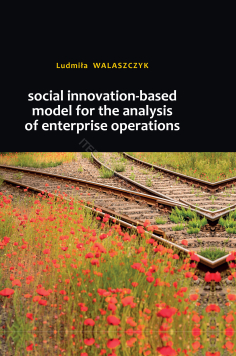Social innovation-based model
The e-book is available for free download here
This publication is available only in the electronic version.
Purpose: the purpose of this monograph is to support the SME management through raising awareness on changes occurring in today’s economy and presenting a social innovation model consisting of two elements, i.e. the methodology for the management of the multicultural skilled workforce in the enterprise (today’s perspective) and the methodology for the implementation of the business succession process in the enterprise (future perspective).
key research question: the main research question is which social problems are nowadays the main barriers for the increase of the effectiveness in the enterprise’s operations in the market.
This question relates to the situation of today’s economy, globalisation, changes in the market, and to the insufficient support for the SMEs in dealing with those changes.
Study design: the proposed model has been developed based on the research carried out between 2016 and 2020 in three European projects: the ProBM project (ERASMUS+ programme), the ENTERtransfer project (INTERREG Central Europe programme), and the CULT_Risk project (ERASMUS+ programme). The research area covered different European countries, depending on the project, but the author focused on the research results relevant for Poland. The following research methods were used: literature review, AHP method, case study, and survey questionnaires with target groups.
Todevelopthemethodologyforthemanagementofthemulticultural skilled workforce in the enterprise, the author used the AHP method in which the partners’ organisations (5) taking part in the CULT_Risk project identified the most crucial areas in which more training was required. In the second stage, the author used a survey questionnaire directed to 30 staff members of the multicultural organisations to verify and confirm on which aspects to focus to ensure the effectiveness of work in enterprises.
As regards the implementation of the business succession process in the enterprise, the author used a case study analysis with 5 business owners who had already implemented a business succession plan in their enterprises, and a survey questionnaire directed to 45 business owners planning the succession in the future.
key results: From the analysis of the situation of the SMEs in the contemporary market and the needs for considering such important aspects as the multiculturality of the skilled workforce and the business succession it followed that most business owners have insufficient knowledge and competencies to deal with those issues, and that they thus need to be trained in intercultural areas first so as to become more familiar with them. The author identified the following key areas for consideration: cross-cultural awareness, understanding different cultures, stereotypes, communication, teamwork, leadership and hierarchy, learning styles and qualities in the working place. The improvement of the staff in the aforementioned areas makes them more aware of the cultural diversity in enterprises and of different cultural risks that may occur.
The second aspect analysed was the implementation of a business succession process in the enterprise. It turned out that for most SMEs the only way is to transfer the enterprise to children or other family members. Based on the discussions with the representatives of enterprises with some previous experience in business succession, other ways of transferring enterprises have been identified, i.e. taking over by unrelated third-party managers or other competent professionals. It was a totally new approach for most of SMEs.
highlights of the discussion: the research performed with the SME representatives has shown that they are not always aware of changes occurring in the market. They agreed with the author that a complex model covering these two aspects would be beneficial for them. Therefore, the developed model is mainly dedicated to SMEs as these are enterprises which constitute more than 99% of all enterprises in the market and which can have problems with the cultural diversity and the transfer of the enterprises to potential successors.





